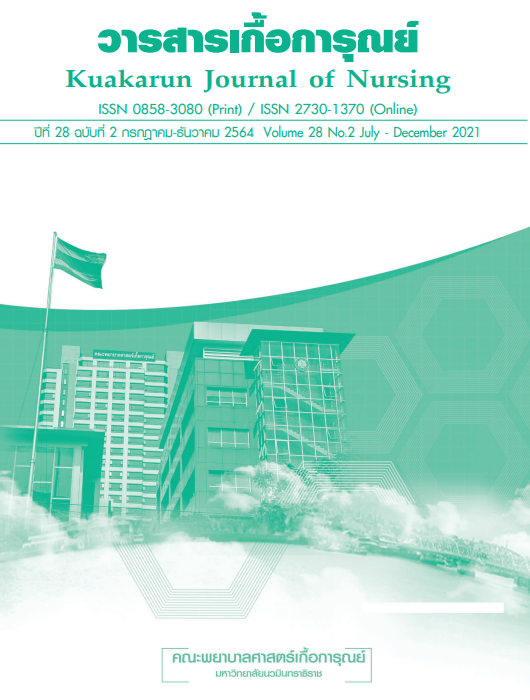ผู้สูงอายุกับพฤติกรรมเนือยนิ่งในสถานการณ์การระบาดโรคติดเชื้อไวรัสโคโรนา 2019
คำสำคัญ:
ผู้สูงอายุ, พฤติกรรมเนือยนิ่ง, โรคติดเชื้อไวรัสโคโรนา 2019บทคัดย่อ
สถานการณ์การแพร่ระบาดของโรคติดเชื้อไวรัสโคโรนา 2019 กระทบต่อการดำเนินชีวิต ทั้งด้านร่างกาย จิตใจ และเศรษฐกิจของประชาชน โดยเฉพาะผู้สูงอายุเป็นกลุ่มเสี่ยงสำคัญที่ต้องปฏิบัติ ตามมาตรการการเว้นระยะห่างทางสังคมเพื่อป้องกันการติดเชื้อ และควบคุมการแพร่กระจายเชื้อ ส่งผลให้เกิดการเปลี่ยนแปลงการดำเนินชีวิตประจำวัน และการมีปฏิสัมพันธ์กับสังคมลดลง สะท้อนถึงการมีกิจกรรมทางกายลดน้อยลง เกิดเป็นพฤติกรรมเนือยนิ่งที่เป็นปัจจัยเสี่ยงต่อการเกิดปัญหาด้านสุขภาพกาย เช่น โรคหัวใจ โรคความดันโลหิตสูง โรคเบาหวาน โรคมะเร็ง และโรคสมองเสื่อมในผู้สูงอายุ รวมถึงปัญหาสุขภาพจิต ได้แก่ ความรู้สึกว้าเหว่ ภาวะซึมเศร้า เป็นต้น พยาบาลวิชาชีพผู้ปฏิบัติงานในการดูแลสุขภาพผู้สูงอายุควรตระหนักถึงปัญหาสุขภาพที่เกิดขึ้นจากพฤติกรรมเนือยนิ่ง ปัจจัยที่เกี่ยวข้อง ผลกระทบ ของพฤติกรรมเนือยนิ่ง แนวทางการประเมิน และการส่งเสริมกิจกรรมทางกายของผู้สูงอายุ ท่ามกลาง การดำเนินชีวิตช่วงการระบาดของโรคติดเชื้อไวรัสโคโรนา 2019 เพื่อนำไปสู่การวางแผนส่งเสริมสุขภาพ โดยเฉพาะกิจกรรมทางกายที่เหมาะสมในผู้สูงอายุตามศักยภาพ และลดความเสี่ยงต่อการเกิดปัญหาสุขภาพทางด้านร่างกาย จิตใจ อารมณ์ และสังคมของผู้สูงอายุ
เอกสารอ้างอิง
Dong E, Du H, Gardner L. An interactive web-based dashboard to track COVID-19 in real time. The Lancet Infectious Diseases 2020;20(5):533-4.
Department of Disease Control, Ministry of Public Health. Coronavirus disease prevention and control guide 2019 for the people. Bangkok: Agricultural cooperative printing demonstrations of Thai; 2020. (in Thai)
Department of Health. Advice for the elderly in the situation of the coronavirus disease 2019 epidemic, 2020 [Internet]. 2021 [cited 2021 Aug 27]. Available from: http://covid19.anamai.moph.go.th/th/ (in Thai)
CDC COVID-19 Response Team. Severe outcomes among patients with coronavirus disease 2019 (COVID-19) - United States, February 12-March 16, 2020. Morbidity and Mortality Weekly Report 2020;69(12):343-6.
Department of Older Persons. The number of new and cumulative cases of COVID-19 in the country between April and August 27, 2021 [Internet]. 2021 [cited 2021 Aug 27]. Available from: https://www.dop.go.th/th/know/side/1/1/857 (in Thai)
Department of Disease Control. Older adults’ death from COVID-19 [Internet]. 2021 [cited 2021 Aug 27]. Available from: https://ddc.moph.go.th/covid19-dashboard/?dashboard=death-statistics (in Thai)
Kirdmanee B, Tumtavitikul S, Wachirasurong Y, Sukbot B, Teekasap S. Concepts and guidelines for solving Covid-19. Advanced Science Journal 2020;20(1):1-12. (in Thai)
Loyola WS, Torres CV, Camillo CA, Probst VS. Effects of an exercise model based on functional circuits in an older population with different levels of social participation. Geriatrics & Gerontology International 2018;18(2):216-23.
Tyrrell CJ, Williams KN. The paradox of social distancing: implications for older adults in the context of COVID-19. Psychological Trauma: Theory, Research, Practice, and Policy 2020;12:S214-6.
Biswas A, Oh PI, Faulkner GE, Bajaj RR, Silver MA, Mitchell MS, et al. Sedentary time and its association with risk for disease incidence, mortality, and hospitalization in adults: a systematic review and meta-analysis. Annals of Internal Medicine 2015;162(2):123-32.
Lynch BM, Owen N. Too much sitting and chronic disease risk: steps to move the science forward. Annals of Internal Medicine 2015;162(2):146-7.
World Health Organization. Global recommendations on physical activity for health [Internet]. 2010 [cited 2021 May 22]. Available from: https://www.who.int/publications/i/item/9789241599979
Tremblay MS, Aubert S, Barnes JD, Saunders TJ, Carson V, Latimer-Cheung AE, et al. Sedentary behavior research network (SBRN) - terminology consensus project process and outcome. International Journal of Behavioral Nutrition and Physical Activity 2017;14(1):75.
Campbell CM. Methods of physical activity assessment in older adult [Dissertation]. Ames: Iowa State University; 2012.
Tremblay MS, Colley RC, Saunders TJ, Healy GN, Owen N. Physiological and health implications of a sedentary lifestyle. Applied Physiology, Nutrition, and Metabolism 2010;35(6):725-40.
Chastin Sebastien FM, De CM, Cardon G, Lien N, Bernaards C, Buck C, et al. The SOS-framework (systems of sedentary behaviours): an international transdisciplinary consensus framework for the study of determinants, research priorities and policy on sedentary behaviour across the life course: a DEDIPAC-study. International Journal of Behavioral Nutrition and Physical Activity 2016;18(83):1-13.
Hongchayangkool K, Sutheravut P, Kaewthong Y. Guide to increasing physical activity in Thai people. Songkhla: Institute of Health Systems Management Prince of Songkhla University; 2018. (in Thai)
Bauman A, Phongsavan P, Schoeppe S, Owen N. Physical activity measurement--a primer for health promotion. Journal of Education and Health Promotion 2006;13(2):92-103.
Craig CL, Marshall AL, Sjostrom M, Bauman AE, Booth ML, Ainsworth BE, et al. International physical activity questionnaire: 12-country reliability and validity. Medicine and Science in Sports Andexercise 2003;35(8):1381-95.
Rattanawiwatpong P, Khunphasee A, Pongurgsorn C, Intarakamhang P. Validity and reliability of the Thai version of short format International Physical Activity Questionnaire (IPAQ). Journal of Thai Rehabilitation Medicine 2006;16(3):147-60. (in Thai)
Bull FC, Maslin TS, Armstrong T. Global physical activity questionnaire (GPAQ): nine country reliability and validity study. Journal of Physical Activity and Health 2009;6(6):790-804.
Department of Health Ministry of Public Health. Manual for global physical activity surveillance among general population in province by cross-sectional [Internet]. 2009 [cited 2021 Aug 28]. Available from: http://203.157.7.40 /exercise/tiki-download_file.php?fileId=20 (in Thai)
Rosenberg DE, Norman GJ, Wagner N, Patrick K, Calfas KJ, Sallis JF. Reliability and validity of the sedentary behavior questionnaire (SBQ) for adults. Journal of Physical Activity and Health 2010;7(6):697-705.
Wongpipit W, Kritpet T, Phongphibool S. Physical activity and sedentary behavior: guidelines and assessment. Journal of Sports Science and Health 2020;21(1):1-21. (in Thai)
Institute of Geriatric Medicine, Department of Medical Services, Ministry of Public Health. Guidelines for caring for the elderly during the COVID-19 pandemics 2020 [Internet]. 2020 [cited 2021 May 20]. Available from: https://covid19.dms.go.th/backend/Content/Content_File/Covid_Health/Attach/25630406112904AM_แนวทางการดูแลผู้สูงอายุในช่วง%20COVID-19%20ระบาด_final.pdf (in Thai)
Ketuwongsa P, Pongpradit K. Regenerating physical activity in Thailand after COVID-19 pandemic: Thailand physical activity knowledge development centre, institute for population and social research Mahidol university, Thai health promotion foundation. 1st ed. Nakhon Pathom: Prabpim Company; 2020. (in Thai)
Purakom A. Promoting physical activity for health in elderly. 1st ed. Nakhon Pathom: Petchkasem Printing Group; 2015. (in Thai)
Ketwongsa P, Choolert P, Iamyaem W, Un-Ampai A, Saengsawang A. Home physical activity guide. 1st ed. Nonthaburi: Sahamitr Printing and Publishing; 2020. (in Thai)
Choose PT. Home exercises from a physical therapist [Internet]. 2020 [cited 2021 May 22]. Available from: https://www.choosept.com/patientresources/videolibrary/detail/home-exercises-from-physical-therapist-floor-mat
Gadudom P, Apinyalungkon K, Janjaroen K, Wae N. Family roles to increase quality of life of older persons in a changing situation. The Southern College Network Journal of Nursing and Public Health 2018;5(3):300-10. (in Thai)















